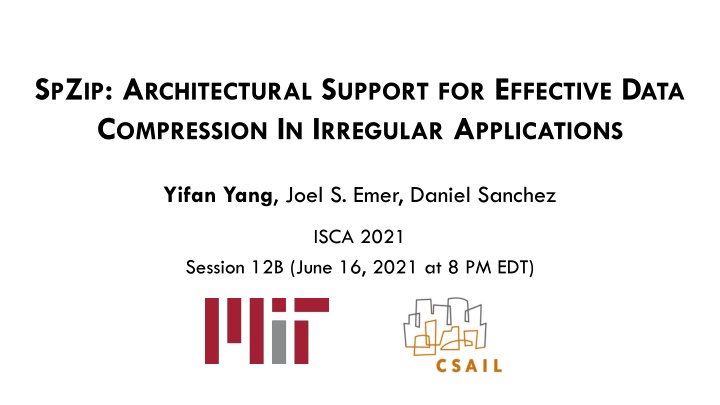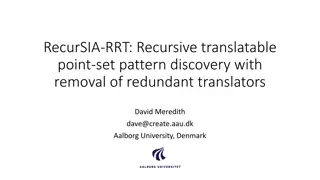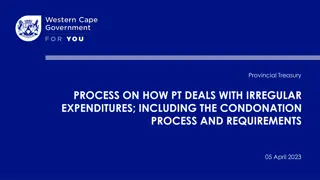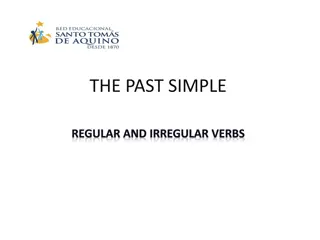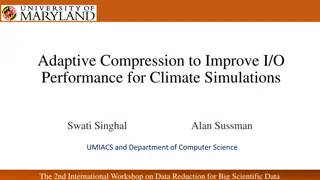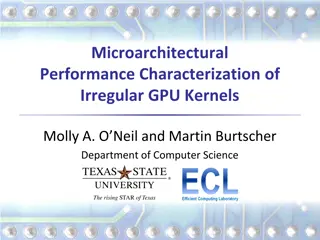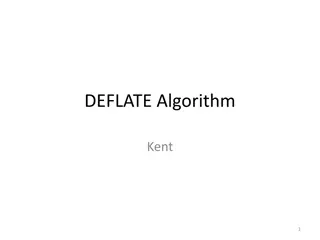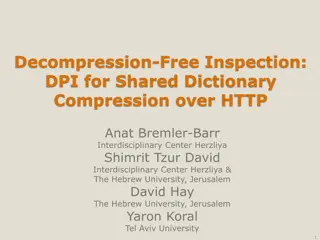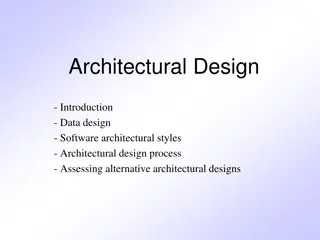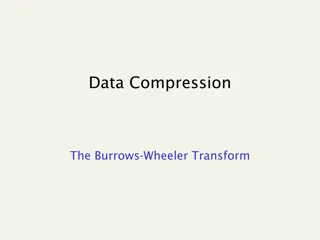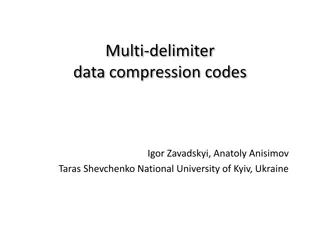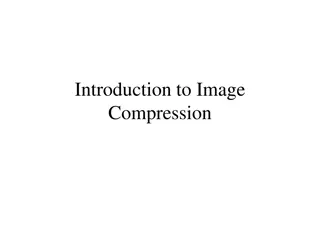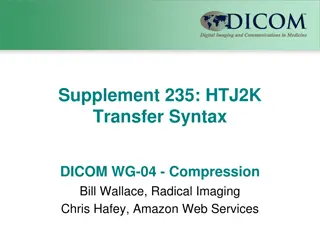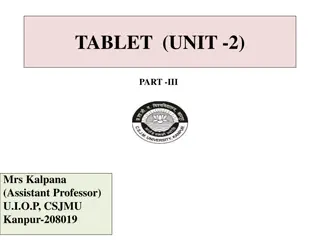Architectural Support for Effective Data Compression in Irregular Applications
Irregular applications, such as graph analytics and sparse linear algebra, are memory-bound workloads. This paper discusses the challenges of compressing data structures in irregular applications, focusing on specialized hardware to accelerate data access and decompression. The study highlights the importance of understanding access patterns and proposes an optimized solution for indirect, data-dependent accesses to short streams, aiming to accelerate irregular applications that existing compression solutions are not tailored for.
Download Presentation

Please find below an Image/Link to download the presentation.
The content on the website is provided AS IS for your information and personal use only. It may not be sold, licensed, or shared on other websites without obtaining consent from the author.If you encounter any issues during the download, it is possible that the publisher has removed the file from their server.
You are allowed to download the files provided on this website for personal or commercial use, subject to the condition that they are used lawfully. All files are the property of their respective owners.
The content on the website is provided AS IS for your information and personal use only. It may not be sold, licensed, or shared on other websites without obtaining consent from the author.
E N D
Presentation Transcript
SPZIP: ARCHITECTURAL SUPPORT FOR EFFECTIVE DATA COMPRESSION IN IRREGULAR APPLICATIONS Yifan Yang, Joel S. Emer, Daniel Sanchez ISCA 2021 Session 12B (June 16, 2021 at 8 PM EDT)
Irregular applications are memory bound 2 Irregular applications, such as graph analytics and sparse linear algebra, are an increasingly important workload domain Social network analysis Navigation Scientific computing Irregular applications are often memory bound Data compression is an attractive approach to accelerate irregular applications
Existing data compression solutions are not tailored for irregular applications 3 Hardware compression units for sequentially accessed long streams e.g., IBM z15 [ISCA 20] Compressed memory hierarchies support random accesses e.g., VSC [ISCA 04] This work is optimized for indirect, data-dependent accesses to short streams
Understanding access patterns in irregular applications 4 Graph Adjacency List v0 v2 v3 vertices neighbors
Existing data compression solutions are not tailored for irregular applications 5 Hardware compression units for sequentially accessed long streams e.g., IBM z15 [ISCA 20] Compressed memory hierarchies support random accesses e.g., VSC [ISCA 04] This work is optimized for indirect, data-dependent accesses to short streams v0 v2 v3 vertices neighbors Data decompression increases critical path latency Limited compression gain on short streams
Compressing data structures in irregular applications is hard 6 Challenge 1: Access and decompression are interleaved Graph Adjacency List vertex data v0 v2 v3 Core vertices neighbors access access access
Compressing data structures in irregular applications is hard 7 Challenge 1: Access and decompression are interleaved Graph Adjacency List vertex data v0 v2 v3 Insight 1: Specialized hw to accelerate data access and decompression Exploit decoupled execution to hide memory access and decompression latencies Fetcher Core vertices compressed neighbors access access decompress access
Compressing data structures in irregular applications is hard 8 Challenge 2: Need to support various access patterns and compression formats Graph Adjacency List v0 v2 v3 Insight 2: Programmable hardware A pipeline consists of a set of composable operators expressing the traversal and decompression of data structures Fetcher Core vertices neighbors Access Access Decompress Dataflow Configuration Language (DCL)
Agenda 9 Motivation SpZip Dataflow Configuration Language (DCL) SpZip Design Evaluation
Dataflow Configuration Language (DCL) overview 10 A DCL program expresses the traversal, decompression and compression of data structures in irregular applications DCL program is an acyclic graph of composable operators Operators are connected by queues to exploit pipeline parallelism Memory access operator Indir ;?2;?1 ;? ?2;?[?1] ; ?2,?2;(?1,?1) ;? ?2 1 , ,?[?2];? ?1 1 , ,?[?1] Range Decompress
Traversing a sparse matrix in DCL 11 Compressed Sparse Row (CSR) format 0 1 2 3 4 in DCL for i in range(numRows): for {col, val} in 0 2 4 5 7 offsets rows[offsets[i]: offsets[i+1]]: rows 1,f 2,d 3,e 2,g 1,a 2,b 0,c in Core visit({col, val}) {coordinate, value} pairs 0 2 4 1,a 2,b 0,c 2,d Memory offsets[0] offsets[1] offsets[2] rows[0] rows[1] rows[2] rows[3] 5 0 Range Range InputQ Accessing rows Accessing offsers OffsetsQ RowsQ
Traversing a sparse matrix in DCL 12 CSR format 0 1 2 3 4 in DCL for i in range(numRows): for {col, val} in offsets rows[offsets[i]: offsets[i+1]]: rows in Core row3 row2 row0 row1 visit({col, val}) uncompressed Range Range InputQ OffsetsQ RowsQ
Data decompression support in DCL 13 CSR with individually compressed rows 0 1 2 3 4 in DCL for i in range(numRows): for {col, val} in offsets decompress( rows[offsets[i]: offsets[i+1]]: compressed ) rows in Core row3 row0 row1 row2 visit({col, val}) compressed Decompress Range Range InputQ Compressed RowsQ OffsetsQ RowsQ
Using DCL in PageRank traversing multiple data structures14 def PageRankIter(Graph g, Array scores, Array contribs) for src in range(g.numVertices): for dst in decompress(g.neighs[g.offsets[src]: g.offsets[src+1]]): scores[dst] += contribs[src] contribs Graph adjacency matrix 0 1 2 3 4 offsets compressed neighs compressed scores ContribsQ Source Vertex Data Range Core Compressed Adjacency Matrix Decompress Range Range InputQ Compressed NeighsQ OffsetsQ NeighsQ Prefetch Destination Vertex Data Indir
Agenda 15 Motivation SpZip Dataflow Configuration Language (DCL) SpZip Design Evaluation
SpZip Overview 16 SpZip augments each CPU core with a programmable fetcher and compressor Main Memory LLC L2 L2 Compressor Compressor Fetcher Fetcher L1 L1 The fetcher accelerates data structure traversal and decompression Core Core The compressor compresses newly generated data before storing it off-chip Fetcher and compressor issue conventional cache line requests
SpZip exploits decoupled execution 17 The fetcher and compressor communicate with core through queues to exploit decoupled execution Compressor Fetcher L1 Core The fetcher runs ahead of the core to traverse and decompress data, hiding memory access and decompression latencies
SpZip fetcher microarchitecture 18 Access Unit and Decompression Unit implement DCL operators L2 Access Unit Range Decomp. Unit Delta Scheduler ctxt 0 BPC Indir ctxt k Scratchpad holds queues between operators q2 Fetcher q0 q1 qn Scratchpad Queues between operators allow pipeline parallelism Core
SpZip fetcher is programmable 19 Scratchpad is configurable to support variable numbers and sizes of queues L2 Access Unit Range Decomp. Unit Delta Scheduler ctxt 0 BPC Indir ctxt k DCL operators are time- multiplexed on the same physical unit q2 Fetcher q0 q1 qn Scratchpad Core ctxt 0 ctxt 1 Scheduler holds operator contexts and chooses which operator to fire each cycle Decompress Range Range Range Range InputQ Compressed NeighsQ OffsetsQ NeighsQ
SpZip compressor overview 20 Compression uses a different set of DCL operators StreamWr MemQ Compress LLC Similar decoupled and programmable design as the fetcher Compress Unit Scheduler ctxt 0 SWU MQU ctxt k q2 See paper for more details Compressor q0 q1 qn Scratchpad Core
Agenda 21 Motivation SpZip Dataflow Configuration Language (DCL) SpZip Design Evaluation
Evaluation Methodology 22 Irregular applications PageRank, PageRank Delta, Connected Components, Radii Estimation, BFS, Degree Counting, SPMV Event-driven simulation using ZSim SpZip system 16 Haswell-like OOO cores 32 MB L3 cache 4 memory controllers (51.2GB/s) SpZip adds 0.2% area overhead of per-core fetcher and compressor Large real world inputs Up to 100 million vertices Up to 1 billion edges
See paper for 24 DCL support for compressing data structures Programmable compressor design Additional evaluation results Impact of preprocessing Benefits over compressed memory hierarchies Impact of decoupled fetching vs data compression
Conclusions 25 Irregular applications have indirect, data-dependent memory access patterns that make compression challenging SpZip makes data compression practical for irregular applications Decoupled execution hides memory access and decompression latencies DCL and programmable design support wide range of data structures and compression formats SpZip achieves significant speedups and memory traffic reductions on irregular applications
THANKS FOR YOUR ATTENTION! ISCA 2021 Session 12B (June 16, 2021 at 8 PM EDT)
